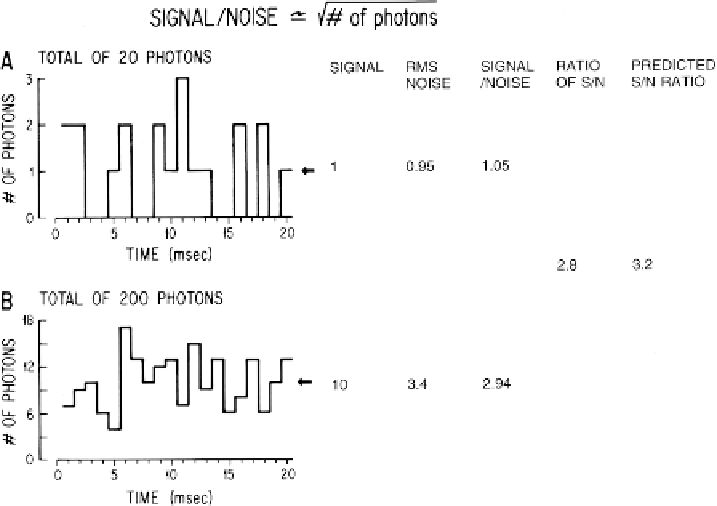Biomedical Engineering Reference
In-Depth Information
Fig. 3.10. Plots of the results of using a table of random numbers to distribute 20 photons (top,
A
) or 200 photons
(bottom,
B
) into 20 time bins. The result illustrates the fact that when more photons are measured, the signal-to-noise
ratio is improved. On the right, the signal-to-noise ratio is measured for the two results. The ratio of the two signal-to-
noise ratios was 0.43. This is close to the ratio predicted by the relationship that the signal-to-noise ratio is proportional
to the square root of the measured intensity.
A to B is similar to that expected from the square-root relation-
ship. This square-root relationship is indicated by the dotted line
in
Fig. 3.11
which plots the light intensity divided by the noise
in the measurement versus the light intensity. In a shot-noise lim-
ited measurement, improvement in the signal-to-noise ratio can
only be obtained by (i). Increasing the illumination intensity. (ii)
Improving the light-gathering efficiency of the measuring system
or (iii) Reducing the bandwidth.
A tungsten filament lamp emits an average of 10
16
photons/ms
and the root-mean-square (RMS) deviation in the number emit-
ted is the square root of this number or 10
8
photons/ms.
However, because only a small fraction of the photons will be
measured, a signal-to-noise ratio of 10
8
(see above) cannot be
achieved. A partial listing of the light losses follows. A 0.9-NA
lamp collector lens would collect 0.1 of the light emitted by
the source. Only 0.2 of that light is in the visible wavelength
range; the remainder is infrared (heat). Limiting the incident
wavelengths to those which have the signal means that only 0.1
of the visible light is used. Thus, the light reaching the prepa-
ration might typically be reduced to 10
13
photons/ms. If the
light-collecting system that forms the image has high efficiency
e.g., in an absorption measurement with matched condenser and
4.1.1.1. The Optimum
Signal to Noise Ratio in a
Wide-Field Measurement

